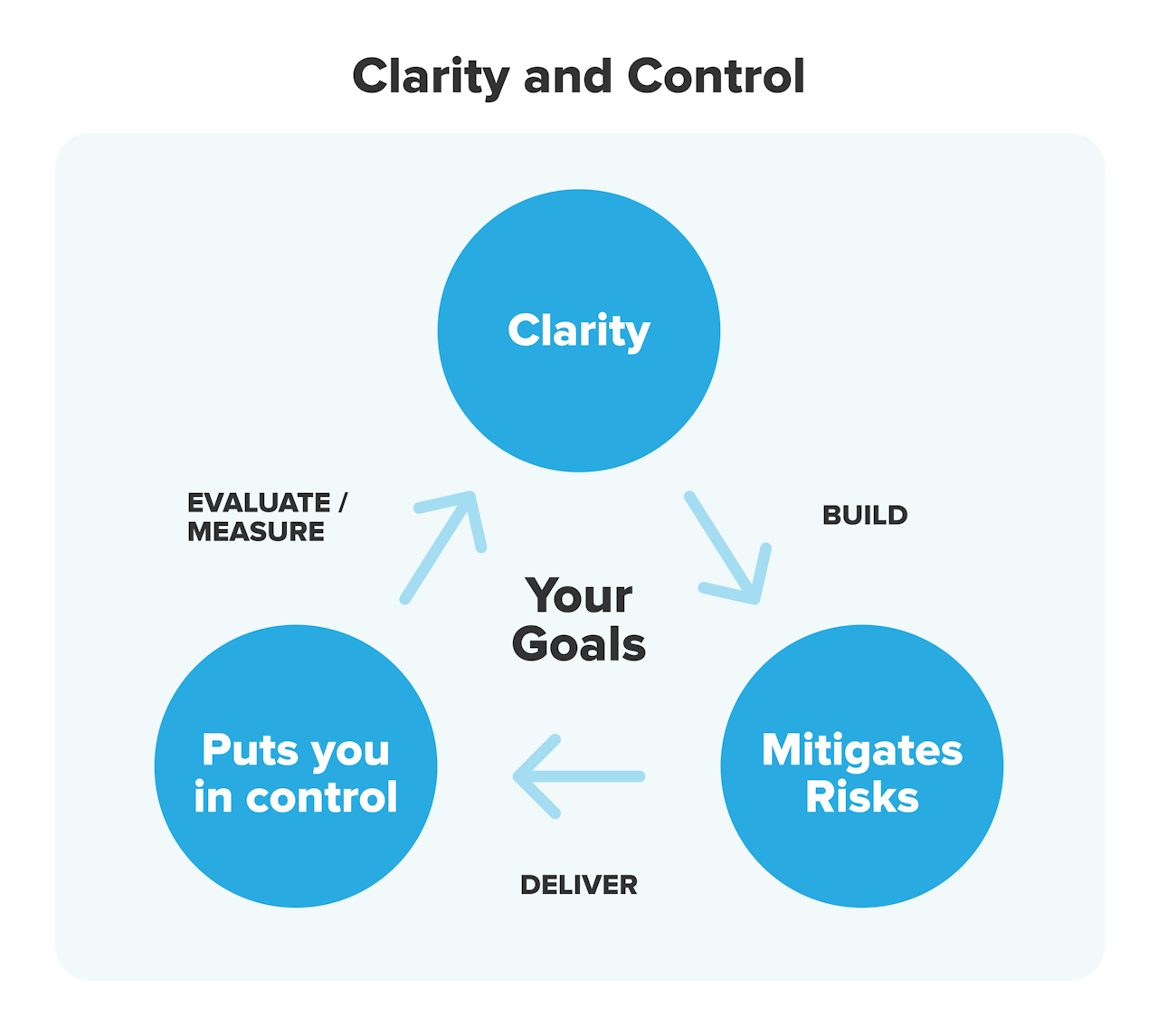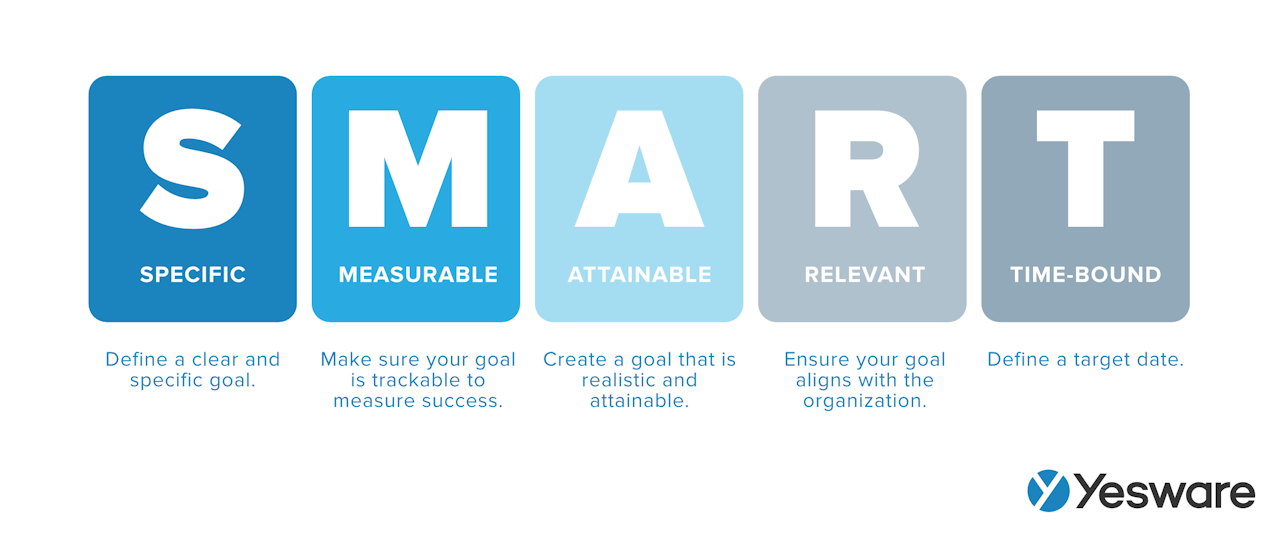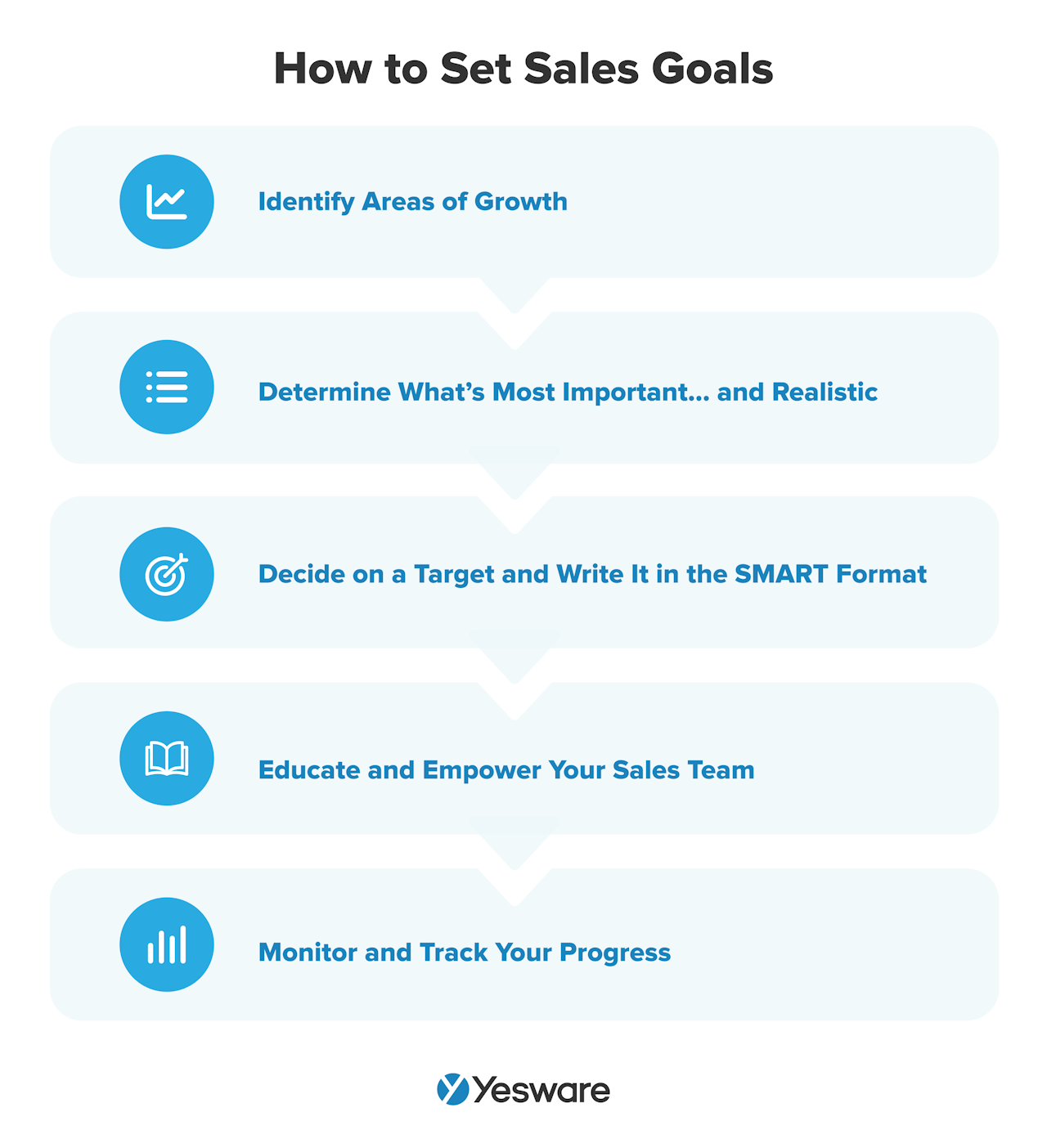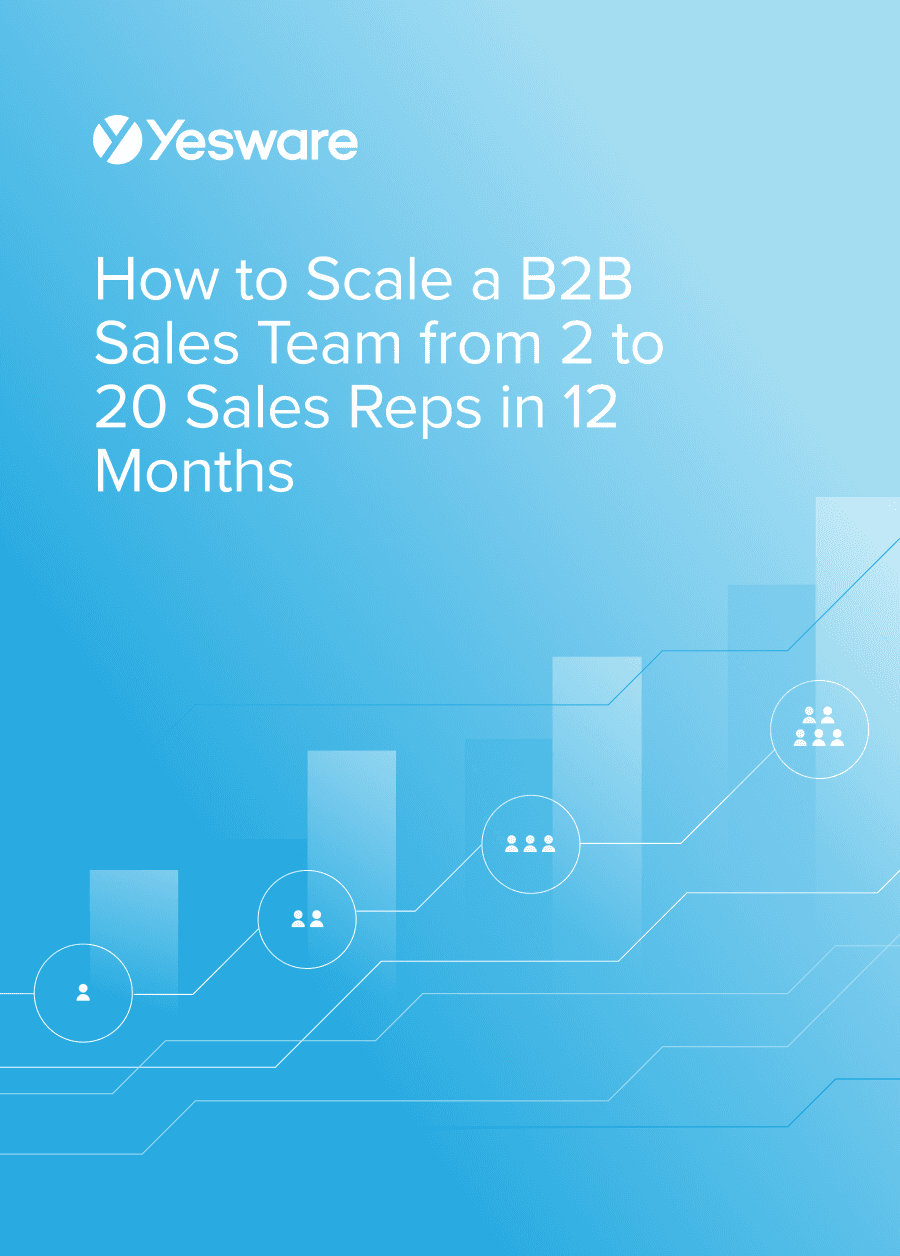15 Sales Goal Examples + How to Set Smart Goals for 2023
Casey O'Connor
Most top-performing sales teams would agree that sales goals are a huge driving force behind their success.
Sales goals are targeted objectives that are designed to help individual sales reps and sales teams stay organized, motivated, and productive as they contribute to business growth.
Without sales goals, many salespeople and teams would become unmotivated, unproductive, and directionless. Sales goals ensure that success is not left up to chance.
In this article, we’ll go over everything you need to know about sales goals, including why they’re so important, how to write them (the right way), and how to track them in a functional and productive way.
Here’s what we’ll cover:
- What Are Sales Goals?
- The Importance of SMART Goals in Sales
- How to Set Sales Goals
- How to Track Sales Goals
- 15 Sales Goals Examples
What Are Sales Goals?
Sales goals are measurable objectives that sales reps and teams use to guide them through their day-to-day sales activities and help them make big-picture strategic decisions.
Sales goals are usually based on sales KPIs and specific sales metrics. They are data-driven and are meant to provide a blueprint for sellers and organizations on how to achieve new levels of success. Sales goals bring clarity and control to the sales process while also mitigating risk.
 The best sales goals strike a delicate balance between being challenging and being achievable.
The best sales goals strike a delicate balance between being challenging and being achievable.
Fortunately, there’s a specific way to write sales goals that helps ensure your sales goals are comprehensive, easy to execute, and impactful: the SMART goal framework.
The Importance of SMART Goals in Sales
The SMART goal framework refers to goals written according to five criteria. SMART goals are: specific, measurable, attainable, relevant, and time-bound.

Let’s take a closer look at what those goal-setting components each mean.
Specific
A well-written sales goal should clearly outline the intended outcome. Sales reps should get a clear picture of what they’ll be working on when they read the goal.
Here’s an example:
Non-Specific Goal: I will increase my sales productivity.
Specific Goal: I will increase the number of sales meetings that I book.
Measurable
Sales reps and managers need to be able to quantify and track progress toward sales goals.
Let’s look at the same example as the one above.
Non-Measurable Goal: I will increase my sales productivity.
Measurable Goal: I will increase the number of sales meetings that I book.
Sales productivity, as a whole, is hard to quantify. There are several factors that go into that metric, and some of the data measurements may be considered subjective.
On the other hand, the number of sales calls a rep makes is an easy metric to measure and track.
Attainable
Every sales team wants to consistently exceed their sales quota, but setting unrealistic goals won’t help anyone perform their best over the long term. Sales reps should feel like they have a decent shot at meeting their goals with some intention and hard work.
Relevant
Individual sales goals should always align with larger organizational goals. For example, if a company sets a goal to move more towards inbound sales, it wouldn’t make sense for a sales rep to create a goal around increasing their cold calls.
Individual goals don’t need to be identical to team- or company-wide ones, but they should at least run parallel to theirs.
Time-bound
Part of what makes a goal a goal — instead of a dream or a wish — is that it has a deadline. A goal needs to be designed around a target date. This creates a sense of urgency and motivation in sales reps who might be working at a challenging pace.
SMART goals are designed to help sales teams and individual salespeople stay focused and productive with manageable yet highly impactful incremental achievements.
How to Set Sales Goals
Sales goals can be created by anyone on the sales team, or upper-level and c-suite management. They sometimes also include the finance team. Sales managers are often responsible for creating team-wide goals, and individual sales reps are encouraged to create personal sales goals, as well.
The same goal-setting process applies whether you’re creating sales goals for yourself or for your team.

1. Identify Areas of Growth
The first step in creating new SMART sales goals is to look carefully at your current sales metrics and KPIs to determine where your biggest strengths and areas of growth are.
To the best of your ability, try to find the root cause of any issues you discover. The better you can identify where exactly deals are getting lost, the more effective your goals will be.
2. Determine What’s Most Important… and Realistic
Virtually all sales goals — assuming they’re written in the SMART format, of course — are worthwhile ones. Most sales teams want to keep reaching new levels of success to help grow their business. And it would be wonderful if every sales team had ample time to pursue every goal they wanted to achieve.
Unfortunately, anyone who works in sales knows this is far from reality. There are only so many resources — time included — available to set and reach goals.
With that in mind, it’s very important that sales reps and sales teams carefully prioritize their potential goals. Evaluate which will make the biggest impact, and/or show the fastest results.
If you’re just starting out with goal-setting, try setting goals related to cash flow, transparency, and productivity. These are all good places to start.
Further, you’ll also need to consider how well your current resources are suited to meeting particular goals. If you set a goal to generate more leads, for example, you may need to hire new or additional business development reps (BDRs) to free up time for more senior reps to close deals. Not every business has the capital or cash flow to commit to something like that, especially in the early stages.
3. Decide on a Target and Write It in the SMART Format
Once you’ve determined your highest priorities and whittled those down to only those that are realistic given the resources available to you, it’s time to map out the specifics of your new sales goal.
Remember to follow the SMART framework carefully. It does take some practice, so take notes on the process as you go. You’ll get better at it the more you use it.
It’s worth noting that activity goals are generally easier to work toward and achieve than outcome-based ones. Take a look at these two examples:
Activity-based: Sales reps will close 40% of prospects that hear their sales proposals.
Outcome-based: The sales team will generate 50% more revenue than last year.
Do you notice the difference between these two? In the activity-based goal, the sales reps’ activity is clear: sales proposals that close deals. They know exactly what they need to work on in order to meet the goal.
The revenue, outcome-based goal, however, might be influenced by a variety of factors. Sales reps have far less control over an outcome-based goal than an activity-based one.
To be clear, both types of goals are perfectly acceptable, and both are widely used. Every company hopes to increase their revenue, and it’s reasonable (and good practice) to set goals toward achieving that. There’s nothing wrong with outcome-based goals. It’s just something to keep in mind if you’re just starting out with goal-setting and are eager to see results.
4. Educate and Empower Your Sales Team
You’ll quickly find that even the best-written SMART goals are relatively useless if your team isn’t informed and motivated about how to reach them.
If you’re creating a team-wide sales goal, make sure you carve out as much time as necessary to explain the goal to your sales reps. You’ll also want to make sure they have all of the training, tools, and other resources that they’ll need to reach those goals available to them.
Finally, it’s also worth exploring whether your current compensation or commission plan is properly aligned with your current SMART goals. For example, if your SMART goals are related to lead generation, you might offer a small bonus or increase in commission to reps who exceed their lead goal.
That’s not to say that you should offer hyper-specific bonuses for every performance metric. You don’t have to necessarily add anything to your compensation plan. But you should consider whether you’re appropriately compensating your team if they’re consistently meeting their goals.
Of course, motivation should be more than extrinsic. It’s important that sales managers create a climate of trust, accountability, and appreciation in order to fully motivate reps to reach high expectations.
5. Monitor and Track Your Progress
The backbone of effective sales goals is how well the stakeholders monitor its progress.
If you can, note within your SMART goal at which intervals you plan to collect data on your goal progress. If this is a team goal, make sure there are clear expectations around how and when to collect goal-related data, and where to store it.
Hitting your sales goals? Grab our free ebook below on scaling your team in 2023.
 How to Scale a B2B Sales Team from 2 to 20 Sales Reps in 12 MonthsA step-by-step blueprint and action plan for growing a sales team in a way that maximizes profitability.
How to Scale a B2B Sales Team from 2 to 20 Sales Reps in 12 MonthsA step-by-step blueprint and action plan for growing a sales team in a way that maximizes profitability.
How to Track Sales Goals
The best way to track sales goals is with a sales dashboard. Here’s an example.
![]()
There are many sales software tools that offer dashboard and reporting capabilities — check out the post with some of our favorite sales dashboards here.
At a minimum, your sales dashboard should display all relevant sales data. Some, though, are more capable than just a simple metrics display, and can actually aggregate and analyze data to indicate progress toward your goals.
If you don’t have a sales dashboard platform and aren’t in a position to acquire one soon, it’s up to you to create a clear and organized system — and the expectations around it — for collecting, managing, synthesizing, and analyzing sales data.
Regardless of whether you use technology or not, tracking your progress toward sales goals is one of the most important parts of the process — even more important than meeting or exceeding them. Without careful monitoring of activities and results related to the goal, sales teams and reps will struggle to know how to improve or what to continue.
15 Sales Goals Examples
There’s no limit to the number of sales goals a team can create. Follow the steps outlined in this article to determine the ones most relevant to your team.
Here are a few examples to use as a starting point. Be sure to update or change the numeric specifics (i.e., the timeline and intended outcome) to fit the needs of your team.
- Increase monthly revenue by 10% in twelve months
- Increase annual revenue by 10% in twelve months
- Reduce customer churn to <1% in six months
- Increase units sold in a quarter by 20%
- Increase customer lifetime value (LTV) by 12% in twelve months
- Decrease customer acquisition cost (CAC) by 5% in six months
- Increase the number of marketing qualified leads (MQL) by 15% in six months
- Increase the number of sales qualified leads (SQL) by 15% in three months
- Reduce the length of the sales cycle by 8% in six months
- Increase win rate by 8% by the end of the year
- Increase hours spent on sales rep coaching by 15% in six months
- Increase the number of sales training opportunities by 10% in three months
- Decrease rep turnover by 8% in twelve months
- Increase the number of leads generated by 20% in three months
- Increase the number of sales demos scheduled by 15% in six months
Do you use SMART sales goals in your sales process? What has been your most successful goal so far? Think both in terms of the goal-setting process, and measured outcome. What worked so well about the process? Why do you think you were able to meet that particular goal so efficiently?
Get sales tips and strategies delivered straight to your inbox.
Yesware will help you generate more sales right from your inbox. Try our Outlook add-on or Gmail Chrome extension for free, forever!
Related Articles
Casey O'Connor
Casey O'Connor
Casey O'Connor
Sales, deal management, and communication tips for your inbox

